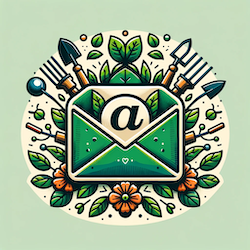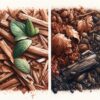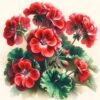Why Are Blue Flowers So Captivating?
Blue flowers hold a unique place in the world of horticulture due to their rarity and striking appearance. They symbolize serenity, stability, and tranquility, making them a sought-after choice for gardeners and floral enthusiasts. The allure of blue flowers lies in their ability to bring a touch of calmness and a sense of wonder to any setting. Their rarity in nature makes them a fascinating and valuable addition to gardens and bouquets, often creating a focal point due to their distinctive hue.
Common Blue Flowers in Bouquets
Creating enchanting bouquets often involves incorporating blue flowers for their distinctive color and charm. Some of the most beloved blue flowers include:
- Hydrangea (‘Nikko Blue’ or ‘Endless Summer’): Known for their large, round flower heads, hydrangeas are a favorite in both gardens and floral arrangements.
- Delphinium (‘Blue Jay’ or ‘Cobalt Dreams’): These flowers are cherished for their tall spikes of rich blue blooms, perfect for adding height and drama to any bouquet.
- Iris (‘Blue Shimmer’ or ‘Victoria Falls’): Irises offer elegance with their striking blue petals and unique shapes.
- Cornflower (‘Blue Boy’ or ‘Blue Diadem’): Also known as Bachelor’s buttons, cornflowers are prized for their bright, true blue color.
- Forget-Me-Not (‘Myosotis sylvatica’): These tiny, delicate flowers add a whimsical touch to arrangements with their soft blue hue.
- Lobelia (‘Crystal Palace’ or ‘Cambridge Blue’): Lobelia’s small, vibrant blue flowers are great for adding texture and depth to bouquets.
- Bellflower (‘Superba’ or ‘Sarastro’): Bellflowers are known for their bell-shaped blooms and range from pale to deep blue shades.
Blue Flowers and Their Symbolism
Blue flowers are often chosen for special occasions due to their deep symbolism. In the language of flowers, blue represents trust, loyalty, wisdom, confidence, and intelligence. This makes them a popular choice for events like graduations, anniversaries, and engagements, where such sentiments are celebrated.
Best Blue Flowers for Home Grown/Cutting Garden
For those interested in cultivating a garden with a focus on blue hues, here are some top choices:
- Blue Rose (‘Blue Moon’): While true blue roses don’t exist, ‘Blue Moon’ offers a lavender-blue hue that’s closest to blue in roses.
- Salvia (‘May Night’ or ‘Blue Hill’): Salvias produce spikes of vivid blue flowers and are a magnet for bees and butterflies.
- Nigella (Love-in-a-Mist ‘Miss Jekyll Blue’): Known for their unique, misty appearance, these flowers add an exotic touch.
- Larkspur (‘Imperial Blue’): A relative of delphiniums, larkspurs have a similar look but are annuals, making them easier to grow.
Care and Tips for Growing Blue Flowers in Your Garden
Growing blue flowers successfully requires understanding their specific needs:
- Soil pH: For some blue flowers like hydrangeas, soil pH can affect bloom color. Acidic soil tends to produce bluer flowers.
- Sunlight: Most blue flowers thrive in full sun but can tolerate partial shade.
- Watering: Regular watering is key, but be cautious of overwatering to prevent root rot.
- Fertilization: Use a balanced fertilizer to promote healthy growth and vibrant blooms.
- Pruning: Regular pruning and deadheading encourage more blooms and maintain plant health.
- Pest and Disease Management: Monitor for pests and diseases and treat them promptly to keep your blue flowers thriving.
Top 20 Cultivars of Blue Flowers with Descriptions
- ‘Blue Danube’ Aster – Offers vibrant blue, daisy-like flowers in late summer and fall.
- ‘Blue Ensign’ Morning Glory – Features stunning, trumpet-shaped deep blue flowers.
- ‘Heavenly Blue’ Lithodora – Known for its electric blue flowers and ground-covering habit.
- ‘Blue Lace’ Delphinium – This cultivar boasts sky-blue flowers with a touch of lavender.
- ‘Gentian Blue’ Bellflower – Offers deep blue, bell-shaped flowers on compact plants.
- ‘Blue Ice’ Bluestar – Has pale blue star-shaped flowers in spring.
- ‘Bluebird’ Columbine – Features distinctive blue and white spurred flowers.
- ‘Blue Wonder’ Catmint – A drought-tolerant choice with lavender-blue flowers.
- ‘Blue Diddley’ Chaste Tree – Small tree with fragrant, lavender-blue flower spikes.
- ‘Blue Cushion’ Lavender – Compact lavender with deep blue-purple flowers.
- ‘Perennial Blue’ Clematis – Climber with large, blue-purple flowers.
- ‘Blue Cloud’ Sea Holly – Known for its steel-blue flowers and spiky texture.
- ‘Blue Cap’ Sea Thrift – Produces bright blue, pom-pom-like flowers.
- ‘Blue Shades’ Anemone – Offers beautiful, poppy-like blue flowers.
- ‘Brunnera Macrophylla’ Jack Frost – Heart-shaped leaves and small, baby-blue flowers.
- ‘Crystal Palace’ Lobelia – Deep blue flowers with a compact habit.
- ‘Blue Spike’ Veronica – Features tall spikes of bright blue flowers.
- ‘Bluebird’ Hydrangea – Lacecap hydrangea with blue flowers in acidic soil.
- ‘Blue Bouquet’ Passion Flower – Exotic-looking climber with striking blue flowers.
- ‘Blue Dune’ Lyme Grass – A grass with silvery-blue foliage, adding texture.
In conclusion, blue flowers offer a unique and captivating addition to any garden or floral arrangement. Their rarity and symbolism make them a treasured choice for various occasions. By understanding their care requirements and choosing the right cultivars, you can enjoy the tranquil beauty of blue blooms in your garden and home.










